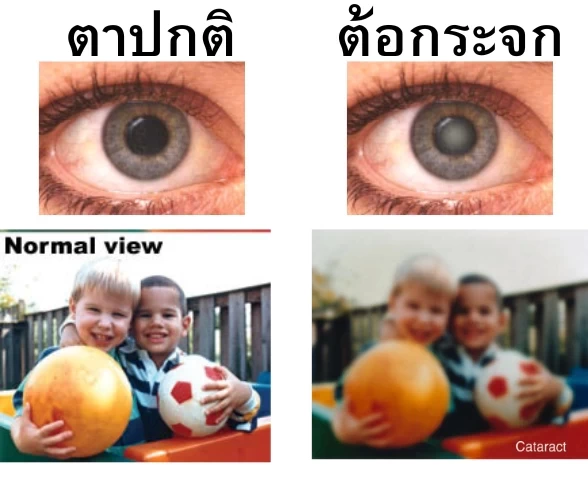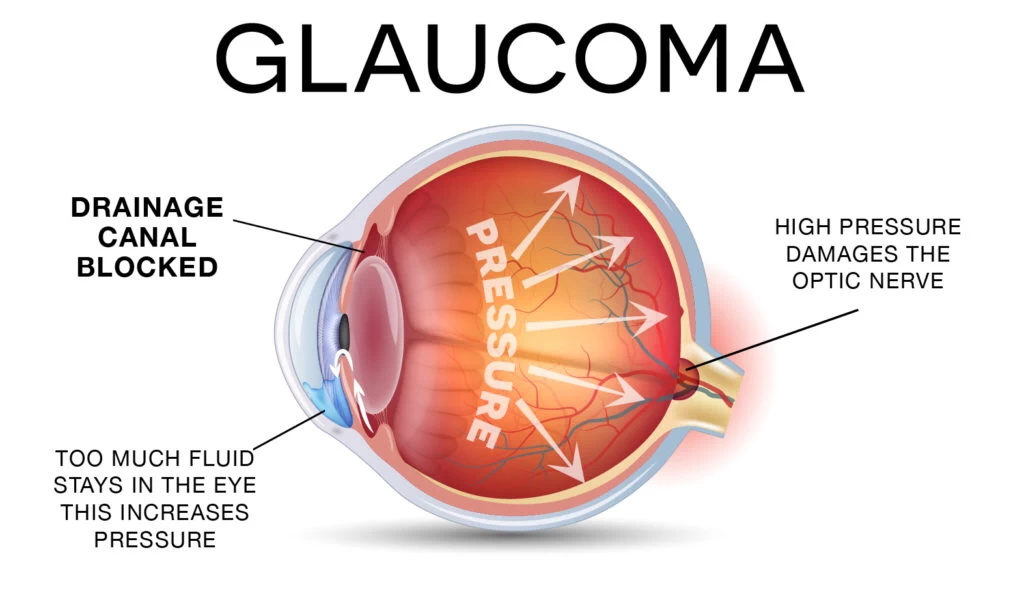
หน้าหลัก | สุขภาพดี | สุภาพสตรี | การแปลผลเลือด | โรคต่างๆ | ยารักษาโรค |วัคซีน | อาหารเพื่อสุขภาพ
โรคและภาวะเกี่ยวกับดวงตาที่มาพร้อมกับอายุ
เมื่ออายุมากขึ้น ดวงตาของเราก็เหมือนกับอวัยวะอื่น ๆ ในร่างกายที่เริ่มเสื่อมสภาพลงตามธรรมชาติ การเปลี่ยนแปลงนี้สามารถนำไปสู่โรคและความผิดปกติทางสายตาหลายชนิด ซึ่งหากไม่ได้รับการดูแลรักษาที่เหมาะสม อาจส่งผลกระทบต่อคุณภาพชีวิตและการมองเห็นในระยะยาว การทำความเข้าใจโรคเหล่านี้จะช่วยให้เราสามารถป้องกันและดูแลสุขภาพดวงตาได้อย่างถูกต้อง

1. โรคตาต้อกระจก (Cataracts)
ต้อกระจก เป็นภาวะที่เลนส์ตา (Lens) ซึ่งทำหน้าที่รวมแสงให้ตกลงบนจอประสาทตา เกิดความขุ่นมัวขึ้น ทำให้การมองเห็นไม่ชัดเจนเหมือนมองผ่านหมอกหรือควัน
เป็นโรคที่พบได้บ่อยที่สุดในผู้สูงอายุ สาเหตุหลักมาจากการเสื่อมสภาพของโปรตีนในเลนส์ตาตามวัย
-
อาการ:
-
การมองเห็นพร่ามัว ไม่คมชัด
-
ภาพซ้อน มองเห็นแสงจ้าเป็นวง
-
สีสันของภาพดูซีดจางลง
-
สายตาเปลี่ยนบ่อย
-
-
การรักษา: การผ่าตัดเปลี่ยนเลนส์ตาเทียมเป็นวิธีเดียวที่สามารถรักษาให้หายขาดได้ ซึ่งเป็นการผ่าตัดที่ปลอดภัยและมีประสิทธิภาพสูง

2. โรคจอประสาทตาเสื่อมตามอายุ (Age-related Macular Degeneration - AMD)
AMD เป็นภาวะที่เซลล์รับภาพบริเวณจุดรับภาพ (Macula) ซึ่งเป็นส่วนสำคัญที่สุดของจอประสาทตาเกิดการเสื่อมสภาพ ทำให้การมองเห็นภาพตรงกลางบิดเบี้ยวหรือมีจุดบอด แต่การมองเห็นภาพด้านข้างยังคงปกติ
โรคนี้แบ่งออกเป็น 2 ชนิดหลัก:
-
ชนิดแห้ง (Dry AMD): เป็นชนิดที่พบได้บ่อยที่สุด เกิดจากการสะสมของสารที่ไม่จำเป็นใต้จอประสาทตา
-
ชนิดเปียก (Wet AMD): เป็นชนิดที่รุนแรงกว่า เกิดจากเส้นเลือดผิดปกติงอกใหม่ใต้จอประสาทตาและมีการรั่วซึมของของเหลว
-
การรักษา: การรักษาจะแตกต่างกันไปตามชนิดของโรค โดยชนิดเปียกจะมีการรักษาด้วยยาฉีดเข้าวุ้นตาเพื่อยับยั้งการเจริญเติบโตของเส้นเลือดผิดปกติ ส่วนชนิดแห้งจะเน้นการชะลอความรุนแรงของโรคด้วยวิตามินและอาหารเสริมบำรุงสายตา

3. โรคต้อหิน (Glaucoma)
ต้อหิน เป็นโรคที่เกิดจากความดันในลูกตาสูงขึ้น ทำให้ขั้วประสาทตาถูกทำลายทีละน้อย ส่งผลให้สูญเสียการมองเห็นภาพด้านข้าง (Visual Field) ในช่วงแรก และหากไม่ได้รับการรักษาอาจทำให้ตาบอดได้ในที่สุด
โรคนี้มักไม่มีอาการในระยะเริ่มต้น จึงถูกเรียกว่า "ภัยเงียบของดวงตา"
-
อาการ:
-
สูญเสียการมองเห็นภาพด้านข้างทีละน้อย
-
การมองเห็นแคบลงเหมือนมองผ่านอุโมงค์
-
ในกรณีต้อหินชนิดมุมปิดเฉียบพลัน อาจมีอาการปวดตา ปวดศีรษะรุนแรง และตาแดง
-
-
การรักษา: การรักษาหลักคือการลดความดันในลูกตาด้วยยาหยอดตา ยารับประทาน เลเซอร์ หรือการผ่าตัด

4. เบาหวานขึ้นจอตา (Diabetic Retinopathy)
เบาหวานขึ้นจอตา เป็นภาวะแทรกซ้อนของโรคเบาหวานที่ส่งผลกระทบต่อหลอดเลือดที่จอประสาทตา เมื่อระดับน้ำตาลในเลือดสูงเป็นเวลานาน จะทำให้หลอดเลือดอ่อนแอและเสียหาย ซึ่งอาจนำไปสู่ภาวะจอประสาทตาบวม เลือดออก หรือจอประสาทตาหลุดลอกได้
-
อาการ:
-
การมองเห็นพร่ามัว มองเห็นจุดดำลอยไปมา
-
การมองเห็นภาพบิดเบี้ยว
-
อาจไม่มีอาการในระยะแรก
-
-
การรักษา: การควบคุมระดับน้ำตาลในเลือดให้ดีเป็นสิ่งสำคัญที่สุด ร่วมกับการรักษาด้วยเลเซอร์ ยาฉีดเข้าวุ้นตา หรือการผ่าตัด
เบาหวานเข้าตา
5. ภาวะตาแห้ง (Dry Eye Syndrome)
ภาวะตาแห้ง เป็นอาการที่พบได้บ่อยในผู้สูงอายุ เกิดจากการผลิตน้ำตาไม่เพียงพอหรือไม่สมดุล ทำให้ดวงตาขาดความชุ่มชื้นและเกิดการระคายเคือง
-
อาการ:
-
รู้สึกเคืองตา แสบตา เหมือนมีสิ่งแปลกปลอมในตา
-
ตาแดง รู้สึกไม่สบายตา
-
น้ำตาไหลมากผิดปกติ
-
-
การรักษา: การใช้ยาหยอดตาชนิดน้ำตาเทียมเป็นวิธีหลักในการบรรเทาอาการ ร่วมกับการปรับพฤติกรรม เช่น หลีกเลี่ยงลมหรือควัน และใช้เครื่องเพิ่มความชื้นในอากาศ
1. ภาวะทางสายตาที่สัมพันธ์กับอายุ (Age-related Conditions)
ภาวะเหล่านี้มักเป็นผลจากการเสื่อมสภาพตามธรรมชาติของดวงตา แต่สามารถเกิดขึ้นได้กับทุกคน:
-
ภาวะสายตาผู้สูงอายุ (Presbyopia): เป็นภาวะที่เลนส์ตาแข็งตัวขึ้น ทำให้ความสามารถในการเพ่งมองวัตถุในระยะใกล้ลดลง ผู้ที่มีภาวะนี้มักจะสังเกตเห็นว่าต้องยื่นแขนออกไปเพื่ออ่านหนังสือหรือข้อความเล็ก ๆ มักเริ่มแสดงอาการหลังอายุ 40 ปี และสามารถแก้ไขได้ด้วยการใช้แว่นอ่านหนังสือ
-
ภาวะวุ้นตาเสื่อม (Floaters): คือจุดเล็ก ๆ หรือเส้นที่ลอยไปมาในสายตา มักสังเกตเห็นได้ชัดในห้องที่มีแสงสว่างมาก ส่วนใหญ่มักเป็นภาวะปกติ แต่หากพบว่ามีจำนวนเพิ่มขึ้นอย่างกะทันหันหรือมีแสงวาบร่วมด้วย อาจเป็นสัญญาณของภาวะที่รุนแรงกว่า เช่น จอประสาทตาหลุดลอก (Retinal Detachment) ซึ่งควรรีบไปพบจักษุแพทย์ทันที
-
ภาวะน้ำตาไหลมาก (Tearing): อาจเกิดจากดวงตาไวต่อแสง, ลม, หรือการเปลี่ยนแปลงอุณหภูมิ การสวมแว่นกันแดดช่วยได้ แต่หากมีอาการเรื้อรังอาจเกิดจากท่อน้ำตาอุดตันหรือการติดเชื้อ ซึ่งควรรักษาโดยจักษุแพทย์
การดูแลและป้องกันสุขภาพดวงตา
การดูแลสุขภาพดวงตาตั้งแต่อายุยังน้อยสามารถช่วยชะลอการเสื่อมของดวงตาได้:
-
ตรวจสุขภาพตาเป็นประจำ: โดยเฉพาะผู้ที่มีอายุ 40 ปีขึ้นไป ควรตรวจสุขภาพตาทุก 1-2 ปี
-
ควบคุมโรคประจำตัว: ควบคุมระดับน้ำตาลในเลือดและความดันโลหิตให้เป็นปกติ
-
รับประทานอาหารบำรุงสายตา: เช่น ผักใบเขียวเข้ม ผลไม้ และอาหารที่มีวิตามิน C, E และ Beta-carotene สูง
-
ปกป้องดวงตาจากแสงแดด: สวมแว่นกันแดดที่สามารถป้องกันรังสี UVA และ UVB ได้
-
งดสูบบุหรี่: การสูบบุหรี่เป็นปัจจัยเสี่ยงสำคัญของโรคตาหลายชนิด
หากมีอาการผิดปกติทางสายตา ควรปรึกษาจักษุแพทย์เพื่อตรวจวินิจฉัยและรักษาอย่างถูกต้อง เพื่อให้สามารถรักษาการมองเห็นที่ชัดเจนไว้ได้นานที่สุด.
เกี่ยวกับผู้เขียน
นพ.ประพันธ์ ปลื้มภาณุภัทร เป็นอายุรแพทย์ 30 ปี แพทย์เวชศสตรครอบครัว...

